Frank Borman dead: Astronaut who commanded Apollo 8 has passed away at age 95 – decades after leading first manned mission to orbit the moon and return safely to Earth
Astronaut Frank Borman, who commanded the historic Apollo 8 Christmas flight in 1968, which orbited the moon ten times and paved the way for the moon landing the following year, has died. He was 95.
Borman died Tuesday in Billings, Montana, according to NASA.
He also led the troubled Eastern Airlines in the 1970s and early 1980s after leaving the astronaut corps.
But he was best known for his NASA duties. He and his crew, James Lovell and William Anders, were the first Apollo mission to fly to the moon – and see Earth as a distant sphere in space.
“Today we commemorate one of NASA’s best. Astronaut Frank Borman was a true American hero,” NASA Administrator Bill Nelson said in a statement Thursday.
This portrait from the late 1960s shows American Colonel Frank Borman, commander of the Apollo 8 flight. Borman, who commanded the historic Apollo 8 Christmas flight in 1968, which orbited the moon 10 times and paved the way for the moon landing seven months later, has died. He was 95
“His lifelong love of aviation and exploration was surpassed only by his love for his wife Susan.”
Launched from Cape Canaveral in Florida on December 21, 1968, the Apollo 8 trio traveled to the moon for three days and entered lunar orbit on Christmas Eve.
After going around ten times on December 24 and 25, they went home on December 27.
On Christmas Eve, the astronauts read from the book of Genesis in a live broadcast from the orbiter: ‘In the beginning God created the heavens and the earth. And the earth was formless and void; and darkness was over the face of the deep.”
Borman concluded the broadcast with, “And on behalf of the crew of Apollo 8, we close with a good night, good luck, a Merry Christmas, and God bless you all – all of you on the good Earth.”
Lovell and Borman had previously flown together on the two-week Gemini 7 mission, which launched on December 4, 1965 – and, just 100 feet apart, completed the first space-orbital encounter with Gemini 6.
“Gemini was a tough call,” Borman told The Associated Press in 1998. ‘It was smaller than the front seat of a Volkswagen Beetle. It made Apollo seem like a super-duper, plush touring bus.”
In his book ‘Countdown: An Autobiography’, Borman said that Apollo 8 was originally supposed to orbit the Earth.
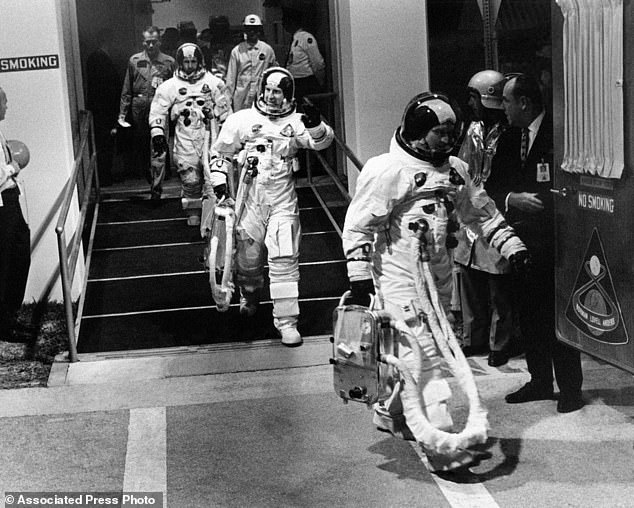
Apollo 8 astronauts, dressed and ready to go, walk to a van en route to their Saturn V rocket for their lunar orbit mission from Cape Kennedy, Florida, December 21, 1968. Leading the way is Commander Frank Borman
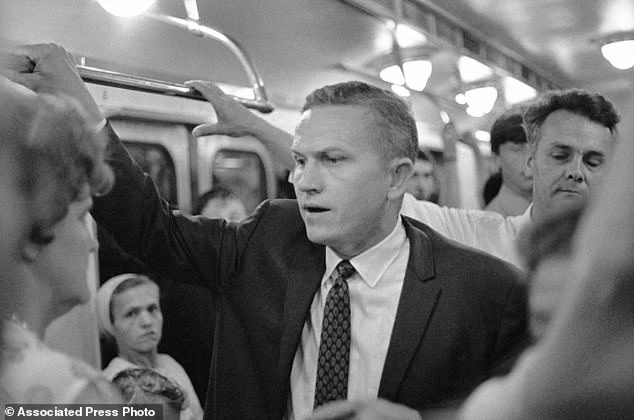
Frank Borman talks to people in the Moscow subway, Russia, July 9, 1969
The success of the Apollo 7 mission in October 1968 to demonstrate the system’s reliability on long flights made NASA decide it was time to attempt a flight to the moon.
But Borman said there was another reason why NASA changed the plan: the agency wanted to beat the Russians. Borman said he thought one job would be enough.
“My biggest concern during this entire flight was getting there before the Russians and getting home. That was a significant achievement in my eyes,” Borman explained during a 2017 performance in Chicago.
It was during the crew’s fourth job that Anders took the iconic photo ‘Earthrise’ photo shows a blue-white Earth rising above the gray moonscape.
Borman wrote about what the Earth looked like from afar: ‘We were the first people to see the world in its majestic totality, an intensely emotional experience for each of us. We didn’t say anything to each other, but I was sure our thoughts were identical: of our families on that spinning globe. And maybe we shared another thought I had: This must be what God sees.”
After NASA, Borman’s aviation career took off in 1970 when he joined Eastern Airlines, then the nation’s fourth-largest airline.
He eventually became president and CEO of Eastern and in 1976 also became chairman of the board of directors.
Borman’s tenure at Eastern caused fuel prices to rise sharply and the government to deregulate the airline industry.
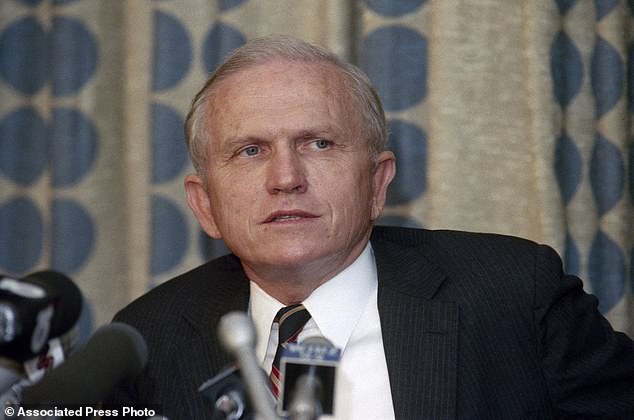
Frank Borman ponders a question at a news conference in Miami, June 3, 1986
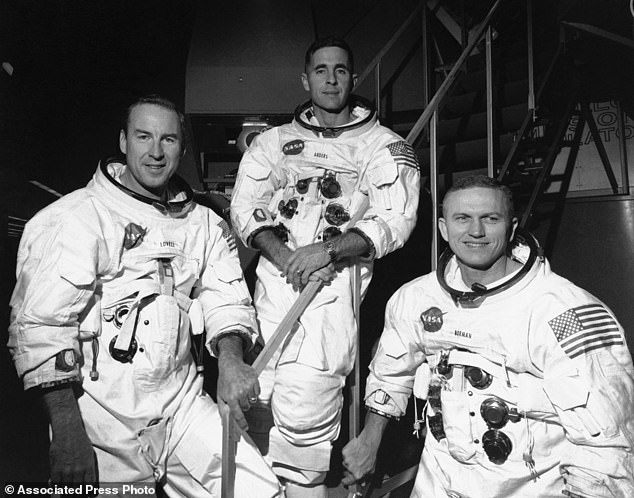
Apollo 8 astronauts, from left to right, James Lovell, command module pilot; William Anders, lunar module pilot; and Frank Borman, commander; stand in front of the mission simulator prior to training for their planned six-day lunar orbital mission at the Kennedy Space Center in Florida
The airline became increasingly unprofitable, struggling with debt and riven by labor tensions. He resigned in 1986 and moved to Las Cruces, New Mexico.
In his autobiography, Borman wrote that his fascination with flying began in his teenage years, when he and his father assembled model airplanes.
At age 15, Borman took flying lessons, using the money he had saved working as a bag boy and getting gas after school.
He made his first solo flight after eight hours of dual flight instruction. He continued flying into his nineties.
Borman was born in Gary, Indiana, but grew up in Tucson, Arizona. He attended the United States Military Academy at West Point, where he received a Bachelor of Science degree in 1950.
That same year, Borman married his high school sweetheart, Susan Bugbee. She passed away in 2021.
After graduating, Borman worked as a fighter pilot, operational pilot and U.S. Air Force instructor at West Point.
In 1956, Borman moved his family to Pasadena, California, where he earned a Master of Science degree in aeronautical engineering from the California Institute of Technology.
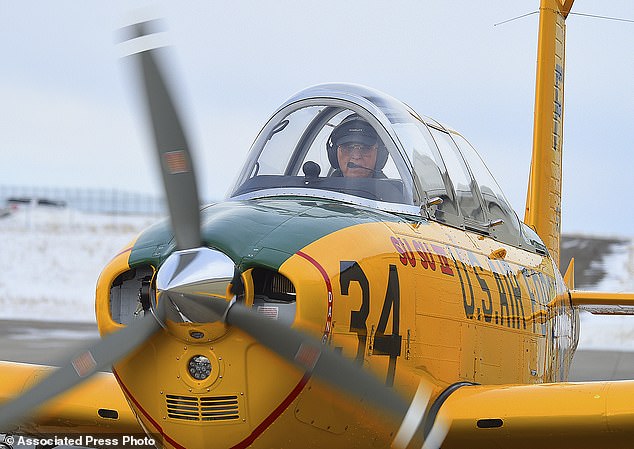
Apollo astronaut Frank Borman, 92, pilots his T-34 Mentor in Billings, Montana
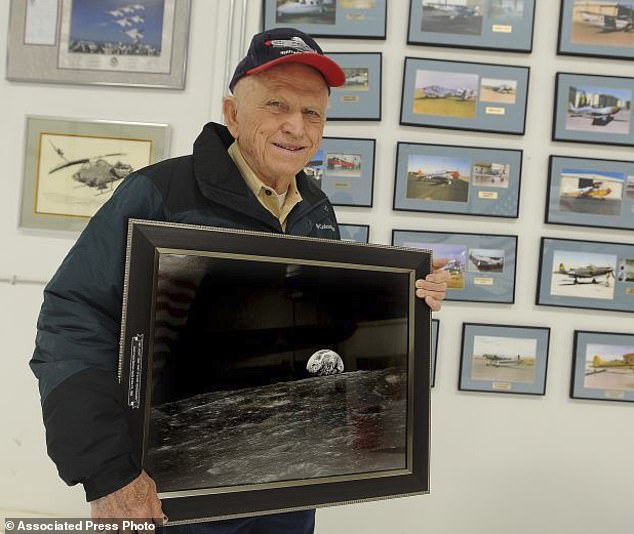
Apollo 8 commander Frank Borman poses in Billings in 2013 with a photo of Earth taken as his spacecraft orbited the moon in 1968
In 1962, he was one of nine test pilots selected by NASA for the astronaut program.
He received the Congressional Space Medal of Honor from President Jimmy Carter.
In 1998, Borman started a cattle ranch in Bighorn, Montana, with his son Fred. In addition to Fred, he is survived by another son, Edwin, and their families.
